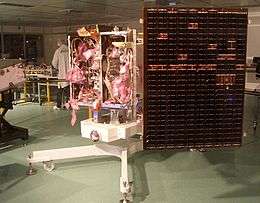Prisma (satellite project)
 Prisma satellite during integration | |
| Mission type | Technology demonstrator |
|---|---|
| Operator | Swedish National Space Board, DLR, CNES |
| COSPAR ID |
Mango: 2010-028B Tango: 2010-028F |
| SATCAT № |
Mango: 36599 Tango: 36827 |
| Mission duration |
1 year planned 6 years and 6 months elapsed |
| Spacecraft properties | |
| Manufacturer | Saab Ericsson Space, Omnisys Instruments, ECAPS |
| Launch mass |
Mango: 145 kg (320 lb) Tango: 50 kg (110 lb) |
| Dimensions |
Mango: 80 cm × 130 cm (31 in × 51 in) Tango: 80 cm × 31 cm (31 in × 12 in) |
| Power |
Mango: 300 watts Tango: 90 watts |
| Start of mission | |
| Launch date | 15 June 2010, 14:42:16 UTC[1] |
| Rocket | Dnepr rocket |
| Launch site | Dombarovsky 370/13 |
| Contractor | ISC Kosmotras |
| Orbital parameters | |
| Reference system | Geocentric |
| Regime | Sun-synchronous |
| Semi-major axis | 7,086 kilometres (4,403 mi)[2] |
| Perigee | 668.3 kilometres (415.3 mi)[2] |
| Apogee | 749 kilometres (465 mi)[2] |
| Inclination | 98.4 degrees[2] |
| Period | 99 minutes[2] |
| Epoch | 24 March 2015, 11:08:39 UTC[2] |
Prisma is a satellite project led by the Swedish Space Corporation (SSC) which consist of two satellites that fly in formation.[1]
It was launched, along with the PICARD spacecraft, on 15 June 2010 on a Dnepr launcher from Dombarovskiy Cosmodrome, near Yasny, Russia. Its primary objective is to test autonomous formation flying.[1][3] A secondary objective was to flight test a new monopropellant thruster using ammonium dinitramide (ADN) propellant.[4]
On 12 August 2010, SSC reported that the two satellites, called Mango and Tango, had separated from each other for the first time.[5]
References
- 1 2 3 "Successful launch of the Swedish Prisma satellites". Swedish Space Corporation. 15 June 2010. Retrieved 16 June 2010.
- 1 2 3 4 5 6 "PRISMA (MANGO) Satellite details 2010-028B NORAD 36599". N2YO. 24 March 2015. Retrieved 24 March 2015.
- ↑ Clark, Stephen (15 June 2010). "French Sun Satellite and Swedish Experiment Blast Off on Russian Rocket". Space.com. Retrieved 16 June 2010.
- ↑ K. Anflo, et al., SSC09-II-4, EXPANDING THE ADN-BASED MONO PROPELLANT THRUSTER FAMILY (accessed 22 July 2014); K. Anflo, et al., SSC07-X-2, FLIGHT DEMONSTRATION OF NEW THRUSTER AND GREEN PROPELLANT TECHNOLOGY ON THE PRISMA SATELLITE (accessed 22 July 2014)
- ↑ "The Swedish Prisma satellites have separated". Swedish Space Corporation. 12 August 2010. Retrieved 12 August 2010.
External links
This article is issued from Wikipedia - version of the 8/12/2016. The text is available under the Creative Commons Attribution/Share Alike but additional terms may apply for the media files.